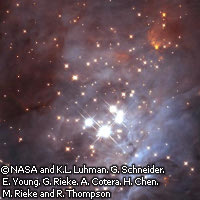Brown dwarfs are a class apart
Researchers at the University of Bonn in Germany have determined that brown dwarfs, celestial bodies whose origins have been a matter of debate, form a class separate from stars and planets. Until now, brown dwarfs were thought to be very small, cool stars. In this latest study, Ingo Thies and Pavel Kroupa of the Argelander Institute of Astronomy reveal that taking brown dwarfs out of the star equation resolves so many theoretical and mathematical problems that they must be considered as being essentially different from stars. The term 'brown dwarf' was coined by Jill Tarter in the 1970s to describe the dimmest and least massive kind of star. Unlike other stars, brown dwarfs, whose mass is between 1 and 8% of the mass of our sun, are not able to fuse hydrogen to produce energy. While stars often occur in pairs wherein the components can be either very close to one another or very far apart, brown dwarfs seem to only be able to exist in very tight pairs; they also seem not to mix with other types of stars, which doesn't fit with the classical model of star formation. The origins of brown dwarfs are a matter of heated discussion. They are broadly considered either to form in a way similar to that of stars or, like some very low-mass stars (VLMSs), to be rejects from a process involving the formation of multiple stars (e.g. in a system with three embryonic stars, the mutual attraction of masses causes the lightest object to be catapulted out). They could, equally, form in the outermost regions of a larger star formation and become separated. The way brown dwarfs behave in pairs, the fact that they don't seem to pair with other types of stars, and their very low temperature and mass together provide more than enough reason to re-examine the classification of these celestial bodies. Mr Thies and Professor Kroupa hypothesised that brown dwarfs form a separate population and showed that indeed, mathematical models of the 'mating' behaviour of other dwarf stars provide more consistent results when the behaviour of brown dwarfs is taken out of the equation. They found that: 'it is unavoidable to invent special mathematical rules for the brown dwarfs', and that 'stars and brown dwarfs must be described separately'. The study shows that the behaviour and structure of brown dwarfs are too difficult to account for under the 'star-like' formation scenario, and that brown dwarfs and very low-mass stars must follow a different formation history from that of other stars. This would mean that brown dwarfs, like planets, emerge at the birth of stars and are a class of celestial body of their own.
Countries
Germany



